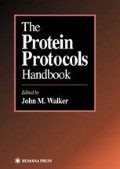Abstract
In isoelectric focusing (IEF), proteins migrate, under the influence of an electrical field, through a pH gradient created by carrier ampholytes (CA). Separation is based on the characteristic isoelectric point (pI) of each protein, which is the pH at which the protein has zero net charge, and thus zero mobility in the electrical field.
Access this chapter
Tax calculation will be finalised at checkout
Purchases are for personal use only
References
Yowell, G., Fazio, S., and Vivilecchia, R. (1993) The analysis of recombinant granulocyte macrophage colony stimulating factor (GM-CSF) by capillary isoelectric focusing. Beckman Application Bulletin A-1744.
Yowell, G. G., Fazio, S. D., and Vivilecchia, R. V. (1993) Analysis of recombinant granulocyte macrophage colony stimulating factor dosage form by capillary electrophoresis, capillary isoelectric focusing and high performance liquid chromatography. J. Chromatog. 652, 215–224.
Pritchett, T. (1994) Qualitative and quantitative analysis of monoclonal antibodies by one-step capillary isoelectric focusing. Beckman Application Information Publication No. A-1769.
Pritchett., T. (1994) Quantitative capillary electrophoresis of monoclonal antibodies using the neutral capillary and the SDS 14–200 method development kits. Beckman Application Information Publication No. A-1772-A.
Molteni, S., Frischknecht, H., and Thorman, W. (1994) Application of dynamic capillary isoelectric focusing to the analysis of human hemoglobin variants. Electrophoresis 15, 22–30.
Hjertén, S. (1992) Isoelectric focusing in capillaries, in Capillary Electrophoresis, Theory and Practice (Grossman, P. D. and Colburn, J. C., eds.), Academic, San Diego, CA, pp. 191–214.
Nolan, J. (1993) Capillary isoelectric focusing using pressure/voltage mobilization. Beckman Application Bulletin A-1750.
Hempe, J. M. (1994) Hemoglobin analysis by capillary isoelectric focusing. Beckman Application Information Publication No. A-1771-A.
Hempe, J. M. and Craver, R. D. (1994) Quantification of hemoglobin variants by capillary isoelectric focusing. J. Clin. Chem. 40, 2288–2295.
Mazzeo, J. R. and Krull, I. S. (1991) Capillary isoelectric focusing of proteins in uncoated fused-silica capillaries using polymeric additives. Anal. Chem. 63, 2852–2857.
Author information
Authors and Affiliations
Editor information
Editors and Affiliations
Rights and permissions
Copyright information
© 1996 Humana Press Inc., Totowa, NJ
About this protocol
Cite this protocol
Pritchett, T.J. (1996). Capillary Isoelectric Focusing with Electro-Osmotic Flow Mobilization. In: Walker, J.M. (eds) The Protein Protocols Handbook. Springer Protocols Handbooks. Humana Press. https://doi.org/10.1007/978-1-60327-259-9_24
Download citation
DOI: https://doi.org/10.1007/978-1-60327-259-9_24
Publisher Name: Humana Press
Print ISBN: 978-0-89603-338-2
Online ISBN: 978-1-60327-259-9
eBook Packages: Springer Book Archive

